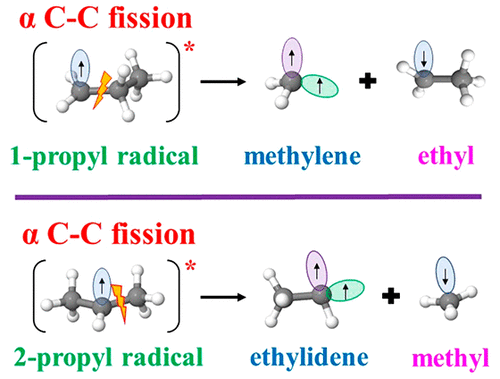当前位置:
X-MOL 学术
›
J. Phys. Chem. Lett.
›
论文详情
Our official English website, www.x-mol.net, welcomes your
feedback! (Note: you will need to create a separate account there.)
Site-Specific Carbon–Carbon Bond Fission in Photoexcited Propyl Radicals Leads to Isomer-Selective Carbene and Radical Products
The Journal of Physical Chemistry Letters ( IF 4.8 ) Pub Date : 2021-12-08 , DOI: 10.1021/acs.jpclett.1c03324 Sagnik Datta 1 , H Floyd Davis 1
The Journal of Physical Chemistry Letters ( IF 4.8 ) Pub Date : 2021-12-08 , DOI: 10.1021/acs.jpclett.1c03324 Sagnik Datta 1 , H Floyd Davis 1
Affiliation

|
Although there have been many studies of C–H bond fission in the UV photochemistry of alkyl radicals, very little is known about the possible occurrence of C–C bond fission. Here, we report that upon excitation at 248 nm, gaseous 1-propyl radicals primarily undergo C–C bond fission, producing methylene (CH2) and ethyl radicals (C2H5), rather than the more energetically favored methyl (CH3) and ethylene (C2H4). In contrast, the exclusive C–C bond fission products from 2-propyl radicals were ethylidene (CHCH3) plus methyl radicals (CH3). The isomer-selective formation of high-energy carbene + radical products involves excited-state site-specific C–C bond fission at the radical carbon, with quantum yields comparable to those for C–H bond fission. Our observations suggest that a general feature of alkyl radical photochemistry is predissociation of the initially formed Rydberg states by high-lying valence states, yielding high-energy carbene plus alkyl radical products.
中文翻译:

光激发丙基自由基中的位点特定碳-碳键裂变导致异构体选择性卡宾和自由基产物
尽管在烷基自由基的紫外光化学中已经有很多关于 C-H 键裂变的研究,但对 C-C 键裂变的可能发生知之甚少。在这里,我们报告说,在 248 nm 处激发时,气态 1-丙基自由基主要发生 C-C 键裂变,产生亚甲基 (CH 2 ) 和乙基自由基 (C 2 H 5 ),而不是更有活力的甲基 (CH 3 )和乙烯(C 2 H 4 )。相比之下,来自 2-丙基自由基的独有 C-C 键裂变产物是亚乙基 (CHCH 3 ) 加甲基自由基 (CH 3)。高能卡宾 + 自由基产物的异构体选择性形成涉及自由基碳的激发态位点特异性 C-C 键裂变,其量子产率与 C-H 键裂变相当。我们的观察表明,烷基自由基光化学的一个一般特征是最初形成的里德堡态通过高价态预解离,产生高能卡宾加烷基自由基产物。
更新日期:2021-12-16
中文翻译:

光激发丙基自由基中的位点特定碳-碳键裂变导致异构体选择性卡宾和自由基产物
尽管在烷基自由基的紫外光化学中已经有很多关于 C-H 键裂变的研究,但对 C-C 键裂变的可能发生知之甚少。在这里,我们报告说,在 248 nm 处激发时,气态 1-丙基自由基主要发生 C-C 键裂变,产生亚甲基 (CH 2 ) 和乙基自由基 (C 2 H 5 ),而不是更有活力的甲基 (CH 3 )和乙烯(C 2 H 4 )。相比之下,来自 2-丙基自由基的独有 C-C 键裂变产物是亚乙基 (CHCH 3 ) 加甲基自由基 (CH 3)。高能卡宾 + 自由基产物的异构体选择性形成涉及自由基碳的激发态位点特异性 C-C 键裂变,其量子产率与 C-H 键裂变相当。我们的观察表明,烷基自由基光化学的一个一般特征是最初形成的里德堡态通过高价态预解离,产生高能卡宾加烷基自由基产物。

































 京公网安备 11010802027423号
京公网安备 11010802027423号